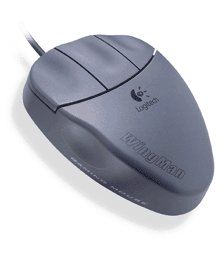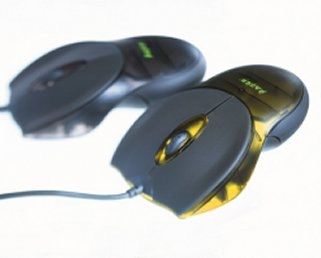|
Gaming Mouse Roundup
Garra Cornish |
||||
|
Logitech Wingman Gaming Mouse
 Fig. 2 Logitech Wingman Gaming Mouse
The Wingman Gaming Mouse is a device targeted directly at the gaming public. Our first clue of this was the fact that is has the words "Gaming Mouse" printed on its side. The next thing that we noticed immediately was that Logitech has replaced the wheel common on most mice with a third, full sized button. Apparently Logitech feels that using a wheel while surfing the net or in Windows applications is less important than a simple, streamlined design. This mouse looks very similar to the MouseMan 96, and the only major difference is the ability to plug the Wingman into either the USB or PS/2 port. The Wingman's drivers come with a custom control panel with a built in PS/2 rate overclocking utility, and we ran the mouse at 200 polls/sec the entire time we used it without a hitch. This increases the strain slightly on the cpu, but the trade off is well worth it, and the sharpness of the cursor movements is evident when running the PS/2 port at polls/sec mhz, even in comparison to the 125 polls/sec speed of the USB port connection. The Wingman is about 33% shorter in length than the Explorer, and at its lowest point about 50% lower in height. The overall feeling is similar to holding a hockey puck with about one quarter of each side chopped off at a 30-degree angle. It is a bit smaller than most mice, and it is very easy to get your whole hand wrapped around it. The right thumb position has a deep indent, and gripping the Wingman between the thumb and the pinky eventually offers one of the most comfortable and natural positions of all the mice we have in the office. Having the three fingers between the thumb and pinky resting on top of this mouse does take a little while to get used to, since almost every other mouse in existence is designed to have the index and middle fingers resting on buttons, and the outside two fingers gripping the right side of the mouse. Once the "getting to know you" phase of using the mouse was over however, it fit everyone here like a glove. Unlike the Explorer, the Wingman is able to have a button configured to "mouse button 3". Most games allow the configuration of 3 buttons in their setup menus, and this is a big plus since it means there is one less key on the keyboard to press. While testing the Wingman, a couple of people here commented that this mouse tracked quite a bit more smoothly then a regular style mouse. I noticed this as well, and I believe that this sensation of increased smoothness is directly related to the small size and shape of the Wingman. |
Unlike the other two mice reviewed, the Wingman offers no new innovative technology. It does however live at the top of the pile of standard motion technology mice currently on the market thanks to its excellent ergonomics, performance, and average online observed price of $29.99 - the lowest price of the three mice reviewed.
 Fig. 3 Razer Boomslang 2000
While the Logitech Wingman Gaming Mouse is a makeover of a pre-existing product, the Boomslang 2000 is a totally new design built exclusively for gamers. Kärna LLC is a start-up company founded in 1998, and utilizing the technology spawned from their breakthroughs in mouse movement tracking systems research, they claim to have found a way to build a better mousetrap. They determined that the two most important factors when it comes to mouse performance are the encoder dpi (dots per inch) and the speed of the controller chip in MIPS (millions of instructions per second). Kärna has hot-rodded the Boomslang 2000 accordingly. In most mice the encoder wheel, which turns when a mouse is moved, typically sends 400-450 discrete signals per inch (DPI). A light beam counts the rotations of the encoder wheel and then sends this information to the controller chip, which interprets the signals as movement. This controller chip operates at around 1.5 MIPS in a typical mouse. What the Boomslang does is increase the resolution of the encoder wheel measuring light to 2000 dpi by focusing the beam of light used to count rotations. As a result, a faster controller chip is required to sort out these increased signals. The Boomslang's chip operates at 6 MIPS, as opposed to the 1.5 MIPS of a regular mouse. These features, combined with a built in PS/2 rate program and optimized mouse drivers are what sets the Boomslang 2000 apart from any other gaming mouse currently available.
|
|||
|
Copyright © 1997 - 2000 COMBATSIM.COM, INC. All Rights Reserved. |
||||
